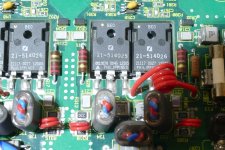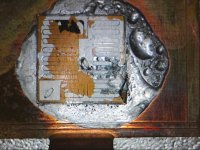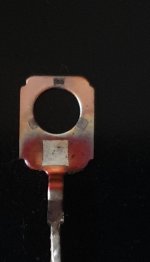So the other day I blew pretty much all the transistors in my amp with my butter fingers. The one time I decide to set the bias without the safety lamp and I short the rails. lol.
So I had the amp up and running in 30 min. But also had a lot of failed transistors. So I thought lets expose the internals and take some macros shots.
I started with my CDIL large drivers. These were hard to open up. Even putting them on the gas stove did not soften the epoxy. But after doing this I moved onto doing the CDIL BD139 / BD140. This time I found the transistors instantly lit up like camphor balls.
The epoxy was highly inflammable. And once burnt out the epoxy just fell away like dust.
Ive seen hundreds of posts on testing transistors but not once have i read of people talking about analyzing the epoxy used.
I find it strange that a company like CDIL would have two types of epoxy in use. And what their logic would be for this.
Its more likely that the BDs were fake. But all of them worked fine. They were all pushed hard and tested on the scope.
Food for thought the next time you blow a transistor and want to see what's inside.
I use a special brand of araldite Highly dielectric epoxy CY205 mixed with powered glass. There is no way in hell I would randomly change the epoxy I have been using for years.
If you do decide to try what I just did. Be safe some of these light up like petrol. Some explode some pop.
So I had the amp up and running in 30 min. But also had a lot of failed transistors. So I thought lets expose the internals and take some macros shots.
I started with my CDIL large drivers. These were hard to open up. Even putting them on the gas stove did not soften the epoxy. But after doing this I moved onto doing the CDIL BD139 / BD140. This time I found the transistors instantly lit up like camphor balls.
The epoxy was highly inflammable. And once burnt out the epoxy just fell away like dust.
Ive seen hundreds of posts on testing transistors but not once have i read of people talking about analyzing the epoxy used.
I find it strange that a company like CDIL would have two types of epoxy in use. And what their logic would be for this.
Its more likely that the BDs were fake. But all of them worked fine. They were all pushed hard and tested on the scope.
Food for thought the next time you blow a transistor and want to see what's inside.
I use a special brand of araldite Highly dielectric epoxy CY205 mixed with powered glass. There is no way in hell I would randomly change the epoxy I have been using for years.
If you do decide to try what I just did. Be safe some of these light up like petrol. Some explode some pop.
Epoxy molded transistors don’t contain BeO. Some old metal can ones did.
Ive seen plastic transistors bust into flame, and others explode and throw pieces across the room. I’ve been hit squarely in the forehead by exploding pieces of TO-247 hexfet.
Ive also see them crack open, glow orange inside and still be working. I’ve had a TDA2002 IC do that, while still playing distorted music! Once it cooled, it was dead as a door nail.
Ive seen plastic transistors bust into flame, and others explode and throw pieces across the room. I’ve been hit squarely in the forehead by exploding pieces of TO-247 hexfet.
Ive also see them crack open, glow orange inside and still be working. I’ve had a TDA2002 IC do that, while still playing distorted music! Once it cooled, it was dead as a door nail.
Some molded transistors and nearly all RF power transistors do contain BeO. These TO247 mosfets are clearly marked, but there are likely some out there that aren't. The main issue with BeO stuff isn't from heating it. It is from any operation like grinding or sanding that would create BeO dust. Even small amounts of BeO dust can cause lung cancer if inhaled. I'm not sure that burning off the plastic would generate enough heat to liberate any BeO molecules, but I'm not going to try it either.
Attachments
Last edited:
You can blow the transistors even with the safety lamp.
The big supply capacitors would have enough energy to destroy them if you make a mistake (Also when shorted just as you just switched off power)..
The big supply capacitors would have enough energy to destroy them if you make a mistake (Also when shorted just as you just switched off power)..
Let me venture a guess to say these don’t go BCE (GDS). When the collector is bonded to tab it is not needed. Regular BCE transistors are going to be “safe” (well, as far as cancer is concerned. Eye protection may be advisable).Some molded transistors and nearly all RF power transistors do contain BeO. These TO247 mosfets are clearly marked, but there are likely some out there that aren't.
The mosfets seen in post #5 are RF power parts. There are two different pin configurations, GSD and DSG. These are similar to the MRF300 parts.
God Bless you!!! Been there done that talk about irritating hope things work out for you.
Best regards
John
Best regards
John
I have a fancy kitchen with a fancy hood extractor. Which I use when the wife is not at home for all my nefarious activities such as heating engine parts and burning transistor epoxy off. Just hope my wife doesnt see this.You must have a good ventilation system..
Hugo
Just don't do this. All harmful substances remain in the filter of the electric vacuum cleaner and can be inhaled.
From US OSHA:
The usual route of harm is:
And cancer from occupational exposures over a longer period.
Acute Beryllium Disease (ABD) - Acute beryllium disease (ABD) is a rapid onset form of chemical pneumonia that results from breathing high airborne concentrations of beryllium. ABD is generally associated with exposure to beryllium levels at or above 100 μg/m3 and may be fatal in 10 percent of cases
The usual route of harm is:
Chronic Beryllium Disease - CBD is a chronic granulomatous lung disease caused by inhaling airborne beryllium after becoming sensitized to beryllium.
And cancer from occupational exposures over a longer period.
- Home
- General Interest
- Everything Else
- Burning Transistors and lessons learned



